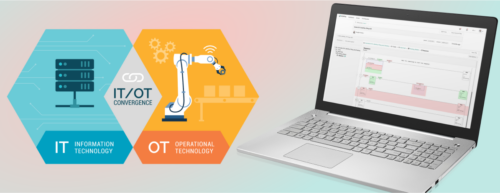Three words that demystify digital transformation
The term “digital transformation” is heard so often in the industrial space that it’s taken on buzzword status, but what does it actually mean? See three words that help clarify and demystify what digital transformation means.
Digital Transformation Insights
- Following the trends of Industry 4.0 through the use of AI is not always the perfect solution for organizations. Digital transformation allows for a more intentional implementation of new technology and processes. Adaptability to new methods and ideologies is essential for efficiency and success of digital transformation within an organization.
- Considering the 3 P’s (Processes, People, Programs) is a key factor when implementing digital transformation. Digital transformation aims to revolutionize processes and emphasizes the importance of an open-minded staff and a methodological approach when deciding to put in place a new technology. This does not come without obstacles, but can help organizations reach their goals when undergoing a digital transformation.
What is digital transformation and how did we get here?
To better understand digital transformation, let’s look back to see how we got to this point. Over the last several years we’ve seen a variety of buzzwords splashed across the headlines. There was the cloud, which led to big data, followed by the edge and the Industrial Internet of Things (IIoT) to collect all this data and bring it into a centralized system. Big Data became bigger data, which had people turning to solutions like machine learning (ML) in the cloud. At this point, if you didn’t have a team of data scientists on retainer, you were told you could still fully realize the power of Industry 4.0 by using artificial intelligence (AI).
Unfortunately, many companies spent years following these trends without seeing meaningful return on investment (ROI). While these technologies certainly have value, they are only part of a bigger picture. Digital transformation isn’t a one-and-done solution, it’s a project management methodology that will be a lens to view all improvements going forward, and something to help you effectively apply new technologies in the future.
Ultimately, digital transformation is a reality check for the buzzword era. It’s the idea of looking at processes to see room for improvement, then improving those areas by leveraging the technology from all these other movements. Gone are the days of technology for the sake of technology. With digital transformation, it’s being replaced with intentional, methodical and measurable improvement. To fully grasp what digital transformation is all about, think of it in terms of these three key words: processes, people and programs.
1. Processes
Industrial organizations each have their own unique process, and the ability to quickly adjust or create new processes is critical. Streamlining processes for efficiency is one of the main opportunities in this area, and the integration of digital technologies such as cloud, edge or machine learning can help with this.
It’s important to note the distinction between mere digitalization and digital transformation. Digitalization simply puts a process into a computer, whereas digital transformation revolutionizes how a process is completed. Rather than just tacking on new technologies to your process, you want to see your process from a bird’s eye view, and make holistic changes, with the outcome of tangible results in mind. Explaining this crucial difference to people can be a little challenging, but it makes a huge difference.
Additionally, locating the problem can take time, and scaling out processes can be difficult. Another potential obstacle is the “if it’s not broke, don’t fix it” mentality that is often found wherever there are entrenched ways of doing things.
2. People
In order for a digital strategy to be successful, you need to take the human factor into consideration. Key stakeholders must be on board with the strategy, and staffing is also critical because you need the right people in the right positions to make it happen.
Opportunity abounds in this area, as communication and collaboration need to be improved across the entire organization. The wider availability of data empowers people to make better decisions, and your workforce will transform as people learn new skills to effectively use the additional data.
As Jan Madsen, founder of Enuda AB (an Ignition Premier Integrator) said, “The overall purpose of digital transformation is, and should always be, to change some human behavior … there’s a lot of engineering and a lot of technologies involved in this, but at the end of the day, it’s about that: Helping people to make better decisions.”
Some obstacles you might face in this area include fixed mindsets resistant to change and perceptions that digital transformation is time-consuming, difficult, risky, has a steep learning curve or poses a threat to cybersecurity. It’s important to acknowledge these concerns while helping people understand that practical solutions are available.
3. Programs
Programs are the “digital” part of digital transformation, and the main way you leverage new technologies and trends. Think of programs as the tools in your digital transformation toolbox. For example, if one of your goals is to improve operational efficiency, you might employ machine learning programs to help calculate efficiency.
When it comes to integrating digital technology, what’s most important is that any new technology you add works alongside what you already have in place, since you’ll mainly be working in brownfield (rather than greenfield) situations. Digital transformation usually means transforming something that already exists.
Major opportunities in this area include improved operational efficiency, time and money savings, and removing limits imposed by outdated technology. When you’re working with up-to-date technologies, things that before seemed too difficult, complicated or expensive to attempt suddenly seem easier to accomplish.
Of course, it’s important to be aware of potential obstacles in this area of your digital transformation strategy. There’s a risk of downtime and disruption, compatibility issues between new and existing programs and the simple fact that integration can be downright difficult.
The future awaits
Hopefully, you now have a clearer understanding of what digital transformation really is, and the opportunities and obstacles to look out for when creating a digital strategy. By remembering the three P’s of processes, people and programs, you’ll be well prepared to truly transform your business and lead it into a very bright future.
– This originally appeared on Inductive Automation’s blog. Inductive Automation is a CFE Media and Technology content partner. Edited by Morgan Green, associate editor, CFE Media and Technology, mgreen@cfemedia.com.
Original content can be found at Inductive Automation.
Do you have experience and expertise with the topics mentioned in this content? You should consider contributing to our CFE Media editorial team and getting the recognition you and your company deserve. Click here to start this process.






